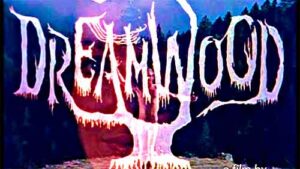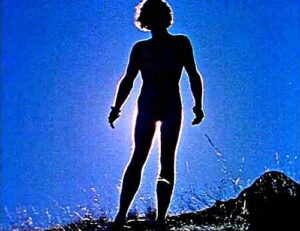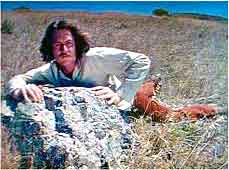The 1972 magnum opus of the late James Broughton (1913-1999), an underground cinema legend since his 1946 debut THE POTTED PSALM. Most of Broughton’s films tended to last around 10-15 minutes, whereas DREAMWOOD runs a whopping 43, with a large cast, a varied set of locations and a narrative that took a form shared by many an early-1970s experimental epic: a surreal fantasy, packed with arcane symbolism and sexual content that borders on pornographic. It was conceived, apparently, as an homage to Jean Cocteau‘s surreal classic BLOOD OF A POET/Le sang d’un poète (1932).
BIG JOY: THE ADVENTURES OF JAMES BROUGHTON (Full Documentary Movie)
There’s no dialogue to speak of in DREAMWOOD, with the only spoken words occuring at the very beginning, when a never-seen narrator informs us that “Somewhere at the center of the world there is a forest of the dream, a sacred wood, a grove of initiation. Somewhere there is what has always been: the treasure hard to obtain, the lair of the great goddess, the bed of the ultimate rapture.” Onscreen we see a naked man (Henry Taylor) lying prone in a forest. That man is revealed in the next scene to be living in a big city apartment, and envisioning a woman, apparently the goddess mentioned in the narration, offering him a shiny bracelet.
Upon seeing the woman led away in a car by a pair of suit-wearing fellows the man runs to the end of a nearby pier. There a Charon stand-in in a rowboat ferries him to an enchanted forest where he’s given a bracelet much like that held by the woman in the previous scene. Thus equipped, the man smashes up a table and mirror at which a trans individual makes himself up (representing, presumably, the protagonist’s highly fluid sexual identity) and strips down upon encountering a nun, who likewise removes her clothes (representing the abandonment of societal repression).
Continuing his quest, the man is attacked by a group of feral children, witnesses a woman get drowned and confronts his own propensity for violence by ecstatically whipping a leather-clad dominatrix. Following more violent and sexual acts he heads for a clearing in the woods, where he passionately makes out with and pees on a patch of dirt, then digs a small hole that allows him to finally attain the desired coupling with the true object of his quest.
All this is set to a soundtrack by electronic music pioneer Morton Subotnik that’s filled with bleeping and whirring that is, if nothing else, very 1970s—a feel that’s accentuated by Broughton’s overuse of the zoom lens. The pace, anticipating the features of David Lynch, is quite glacial (the best way to impart a dreamlike feel), and the framing impeccable, with great texture and perspective. There are portions in which the proceedings attain the type of dream poetry that in later years would be termed Lynchian, and the concluding shot, of the protagonist silhouetted against an evening sky with the moon showing through his torso, ranks as Broughton’s signature image (Broughton also deserves credit for avoiding the expected it’s-all-a-dream fade-out).
Those things, however, don’t forgive the thudding obviousness of the narrative (which is essentially a grown-up WHERE THE WILD THINGS ARE) or Broughton’s distracting overeagerness to shock (which seems pointless given that underground film patrons tend to be pretty jaded). The film ultimately works best as, simply, a highly representative snapshot from an era that was far different, and far more pretentious, than our own.
Vital Statistics
DREAMWOOD
Farallone Films
Director/Screenplay: James Broughton
Producer: Robert Greensfelder
Cinematography: John Schofill, Fred Padula
Editing: Lela Sith
Cast: Henry Taylor, Margo St. James, Diane Nelson, Roger Somers, Evelyn Olivier, Sybil Siegel, Monica Taylor, Claxton Taylor



